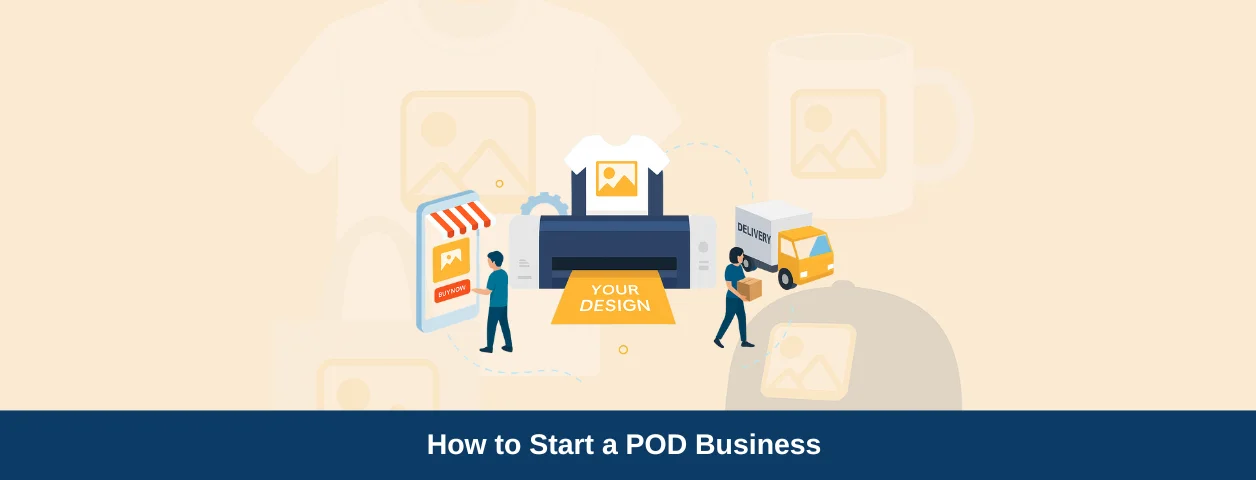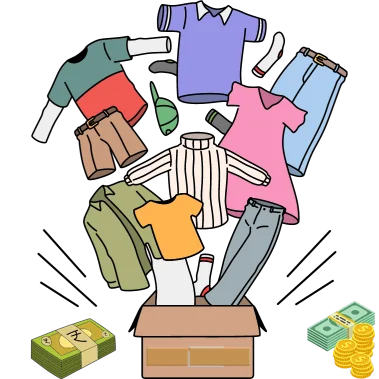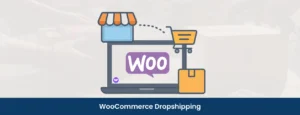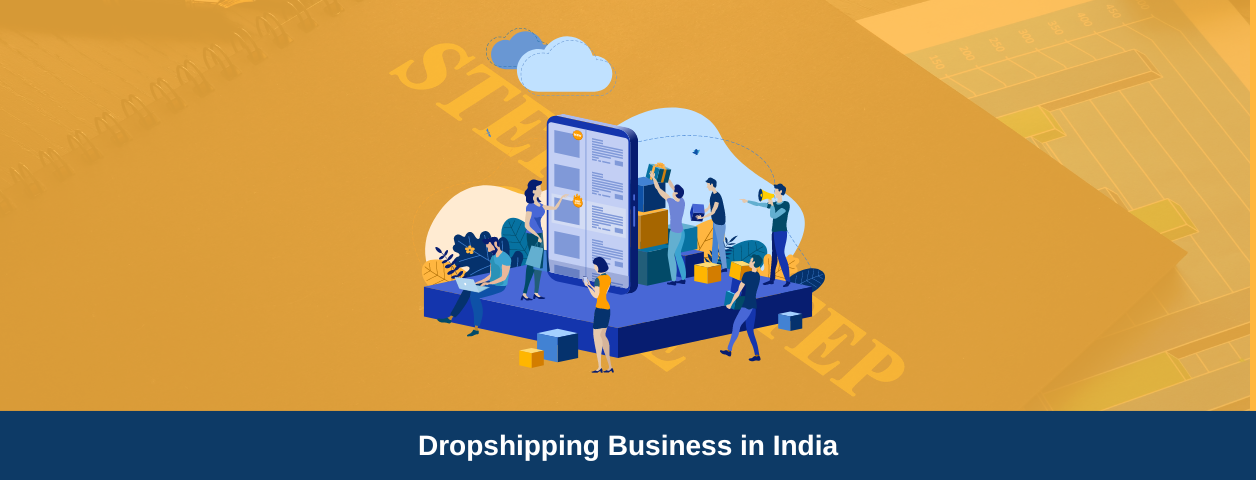Starting an online business no longer requires huge investments or maintaining bulky inventories. Print on Demand has emerged as one of the most popular ways to launch a creative, low-risk eCommerce brand, especially in India, where the demand for personalized products is growing rapidly. From custom t-shirts and mugs to phone cases and stationery, Print on demand lets you design unique items and sell them online without ever handling stock or shipping.
In this complete guide, we’ll walk you through everything you need to know about starting a Print on Demand business in India, how it works, the best platforms and suppliers, costs involved, and step-by-step strategies to build a profitable store.
What is a Print on Demand Business?
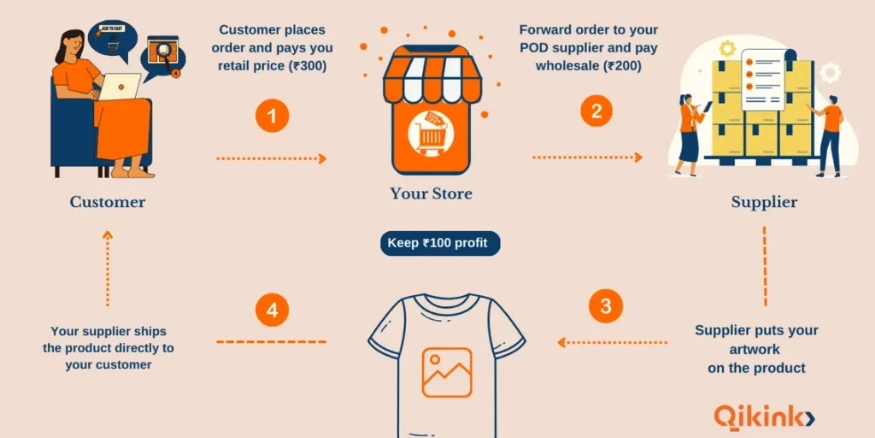
Print on Demand is a business model where products are customized and printed only after a customer places an order. Instead of holding inventory, you partner with a POD supplier who prints your designs on items like t-shirts, hoodies, mugs, phone cases, or stationery and ships them directly to your customers. This makes it a low-risk way to start an online business, as you don’t need to invest in bulk stock, warehouses, or printing equipment.
The process is simple: you choose products, upload your designs, and set up an online store through platforms like Shopify, WooCommerce, Amazon, or Etsy. When a customer orders, the request goes to your POD supplier, who prints and ships the item under your brand name. You pay the base cost and printing fees, and the difference between your retail price and costs becomes your profit.

10-Steps for Launching a Successful Print-on-Demand Business in India
Starting a print-on-demand business is an exciting venture into e-commerce. Here is a clear, step-by-step guide to move from a creative idea to a thriving online store, with a focus on building a sustainable brand.
Step 1: Define Your Niche and Brand Strategy

A focused niche is the foundation of a successful POD business. Instead of trying to sell everything to everyone, a niche allows you to target a specific audience, reduce competition, and build a loyal community.
How to Find Your Profitable Niche:
- Start with Passion & Knowledge: List your interests, hobbies, and communities you are a part of. Think about topics you understand deeply, be it vintage motorcycles, sustainable living, yoga, coding humour, or even a passion for a local culture.
- Validate with Market Research: Passion alone isn’t enough; you need to confirm there’s demand.
- Use Google Trends: Check the search interest for your ideas over time.
- Explore Social Media: Search for hashtags on Instagram, join relevant Facebook groups, and browse subreddits. Is there an active, engaged community around your topic?
- Analyse Marketplaces: Look at what’s selling on Amazon, Myntra, and Etsy. Note the best-sellers but also look for gaps you could fill.
- Conduct Competitor Analysis: Identify 3-5 existing brands in your chosen niche. Don’t just copy them; learn from them. Analyse their:
- Designs: What is their aesthetic? What themes are popular?
- Marketing: How do they reach customers? (Instagram ads, influencers, etc.)
- Weaknesses: What are their customers complaining about in reviews? (e.g., poor quality, slow shipping). This is your opportunity to do better.
Popular & Relevant Niches for 2025:
- Pets: A perennially popular niche with endless design possibilities.
- Hobbies & Professions: From designs for programmers and doctors to bakers and gamers.
- Local & Regional Pride: Create designs celebrating Tamil culture, Kollywood dialogues, or “Namma Ooru” themes that resonate deeply with a local audience.
- Social Causes & Eco-Consciousness: Appeal to values-driven customers with designs promoting sustainability or social justice.
- Seasonal & Festive: Target major Indian festivals like Diwali, Pongal, and Christmas with limited-edition collections.

Step 2: Choose Your Products
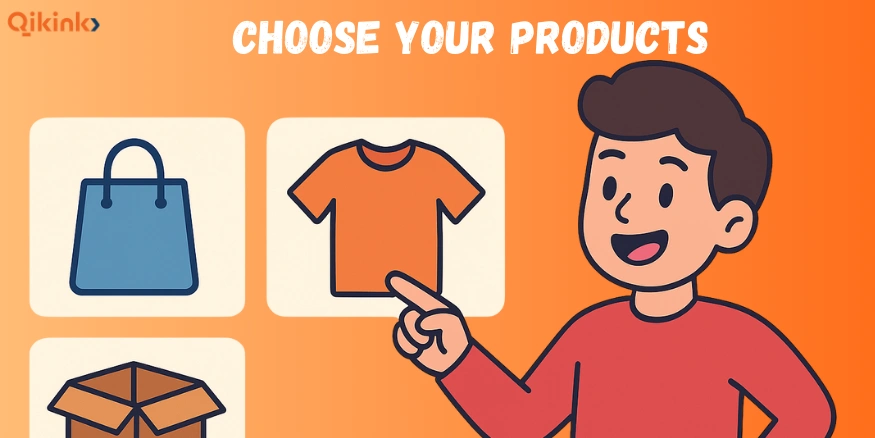
Picking the right products is a crucial step in starting your print-on-demand business. With so many options available, your selection should match your niche and resonate with your target audience.
For example, if your niche is yoga, you could sell t-shirts, leggings, and tote bags with yoga-inspired designs. Aligning products with your niche creates a stronger brand identity and makes your marketing more effective.
Eco-friendly and sustainable items are also trending. Offering organic cotton apparel, recycled-material tote bags, or other eco products can help you stand out and appeal to conscious buyers.
Popular POD Products to Consider:
- T-shirts: Evergreen and versatile, suitable for all audiences.
- Hoodies: Comfortable and stylish, especially in colder seasons.
- Phone Cases: Always in demand and highly customizable.
- Mugs: Great for gifting and personalization.
- Tote Bags: Functional, reusable, and eco-friendly.
- Leggings: Perfect for fitness and lifestyle niches.
- Posters & Art Prints: Ideal for home décor and creative niches.
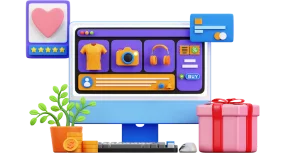
Step 3: Create or Source Your Designs
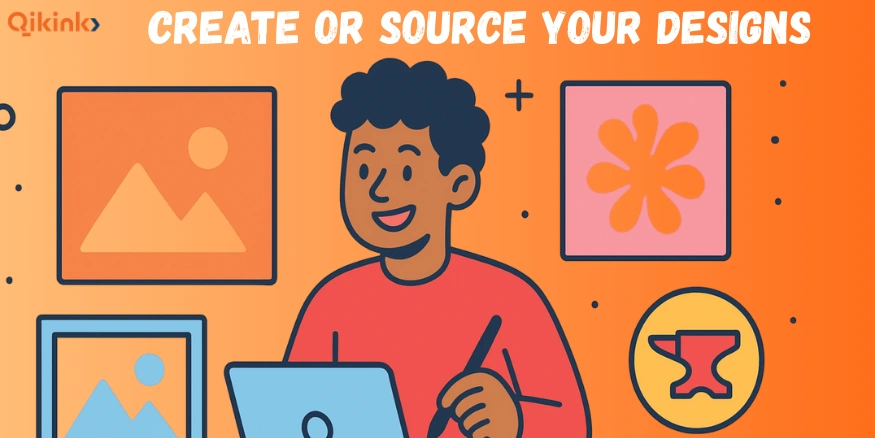
Compelling designs are the foundation of any successful print-on-demand business. They are the primary factor that captures attention, differentiates your products, and ultimately drives sales.
There are several effective ways to develop designs for your POD products:
Ways to create designs:
DIY: If you have design skills, use tools like Illustrator, Photoshop, or Canva to create custom artwork that fits your brand vision.
Premade Designs: Save time by purchasing ready-to-use designs from marketplaces like Creative Market or Etsy
Hire a Designer: For professional, unique work, hire freelancers from platforms like Fiverr or Upwork to design logos, branding, or product graphics.
Test Your Designs:
Before launching, it’s essential to confirm that your designs resonate with your target audience. This can be done through:
Social media polls on platforms like Instagram or Facebook.
Small focus groups drawn from your niche audience.
Surveys distributed via email lists or online communities.
Stay Legal:
Always use original or licensed artwork. Avoid copyrighted images, logos, or characters. Conduct thorough trademark checks before finalizing a design to protect your business from potential legal issues and to maintain brand integrity.
Step 4: Handle Your Business & Legal Setup
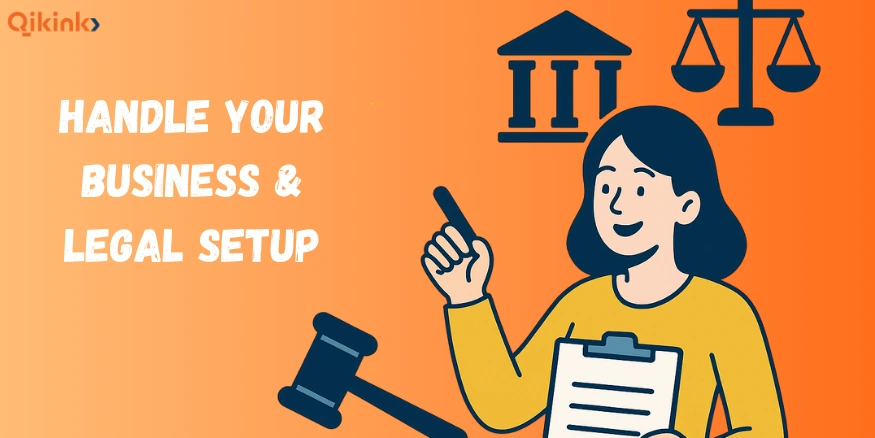
Before you start selling, get the foundational elements in place to operate legally and professionally.
- Business Registration: Start simple with a Sole Proprietorship, which is easy to set up. As you grow, you can consider other structures.
- GST Registration: It is mandatory to register for GST in India to sell goods online, regardless of your turnover.
- Business Bank Account: Open a current account in your business’s name to keep your personal and business finances separate.
- Payment Gateway: Integrate a reliable Indian payment gateway like Razorpay or PayU with your online store to accept payments via UPI, credit/debit cards, and net banking.
Step 5: Choosing the Right POD Supplier
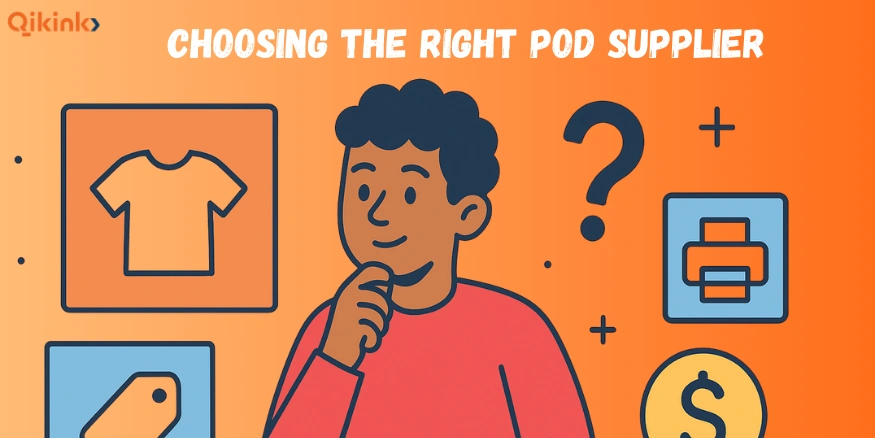
Selecting the right print-on-demand partner is one of the most critical decisions for your business. Since your supplier handles production, printing, and shipping, their reliability directly impacts your customer satisfaction, brand reputation, and scalability.
Key factors to consider when choosing a POD supplier:
Product Quality & Range: Always order samples to check the print and material quality for yourself. Ensure their product catalogue fits your brand’s niche.
Printing Methods: Look for suppliers with modern printing technology like DTG. Better tech means your designs will look more vibrant and last longer.
Pricing & Fees: Compare all costs – product, printing, and shipping fees. Remember that the cheapest option isn’t always the best if it means poor quality.
Shipping Speed & Packaging: Fast and reliable shipping is crucial for keeping your customers happy. Some suppliers also offer custom packaging, which is a great bonus for your brand.
eCommerce Integration: Make sure the provider connects easily with your online store (like Shopify or WooCommerce). Smooth integration will automate your orders and save you time.
Reputation & Support: Always read recent reviews from other sellers. Good customer support is essential when you need help with an order issue.
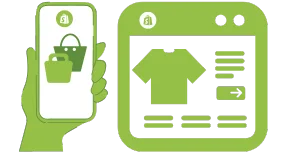
Best Pick for India: Qikink
For Indian entrepreneurs, Qikink is the most reliable POD supplier. It offers affordable pricing, faster domestic shipping, and deep integrations with Shopify and WooCommerce. With high-quality printing, custom branding options, and responsive support, Qikink is ideal for scaling your print-on-demand business locally.
Step 6: Order Samples and Validate Quality
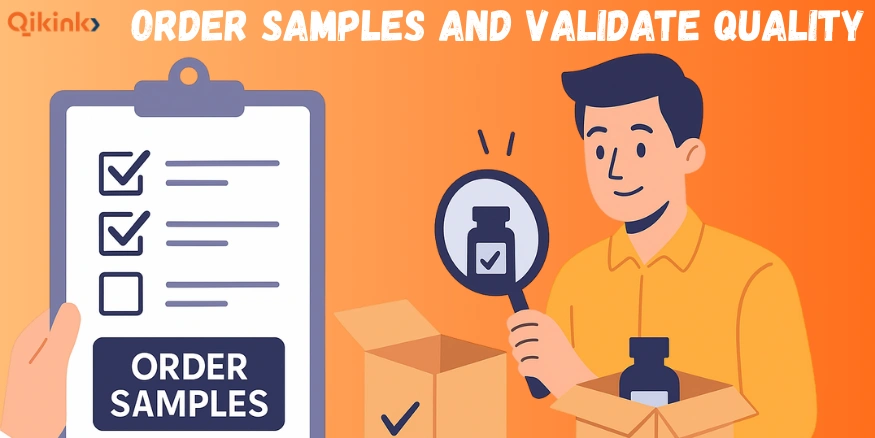
This is a non-negotiable step. Never sell a product you haven’t seen and tested yourself. Order samples of your main products with your designs on them. Evaluate:
- Print Quality: Are the colours accurate? Is the print sharp and durable?
- Garment/Product Quality: How does the fabric feel? Is the sizing correct? Is the mug sturdy?
- The Customer Experience: How long did it take to arrive? How was it packaged?
Step 7: Build & Launch Your Online Store
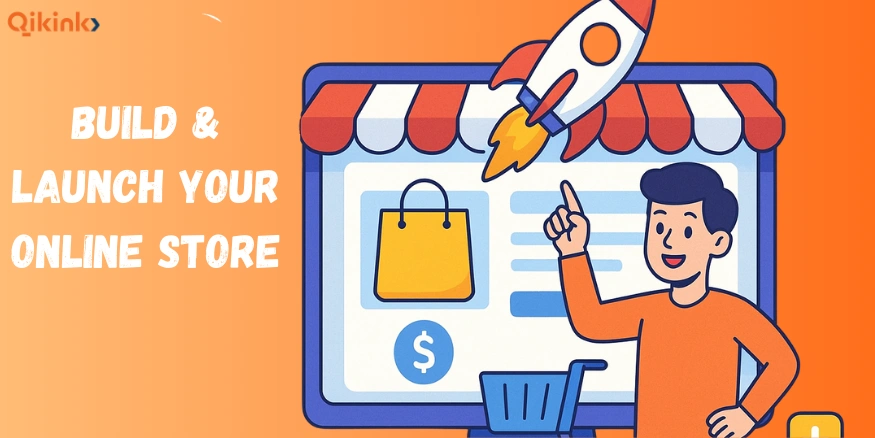
Once you’ve chosen your platform (Shopify, WooCommerce, or others) and POD partner, it’s time to create your digital storefront. The look and feel of your store will directly influence customer trust and sales, so invest time in making it professional and user-friendly.
1. Choose a Clean, Professional Theme
Use free or paid templates to design a store that puts your products in the spotlight. Keep the layout simple, visually appealing, and easy to navigate.
2. Create High-Quality Mockups
Use your POD provider’s mockup tools or platforms like Placeit to showcase your designs on real products. High-quality images help customers visualize what they’re buying and increase conversions.
3. Write Compelling Product Descriptions
Go beyond listing features, tell a story. Explain the inspiration behind your design, highlight the quality, and connect with the customer emotionally. Great copy turns browsers into buyers.
4. Set Up Essential Pages
Build trust by including key pages such as:
- About Us – Share your brand story and mission.
- Contact – Make it easy for customers to reach you.
- Shipping & Delivery Policy – Be clear about timelines and charges.
- Returns & Refunds – Transparency reassures buyers and boosts credibility.
5. Ensure Smooth Checkout & Payments
Offer multiple secure payment options and make the checkout process fast and simple. A seamless buying experience reduces cart abandonment.
Trying to figure out how Etsy selling works?

Step 8: Price your products
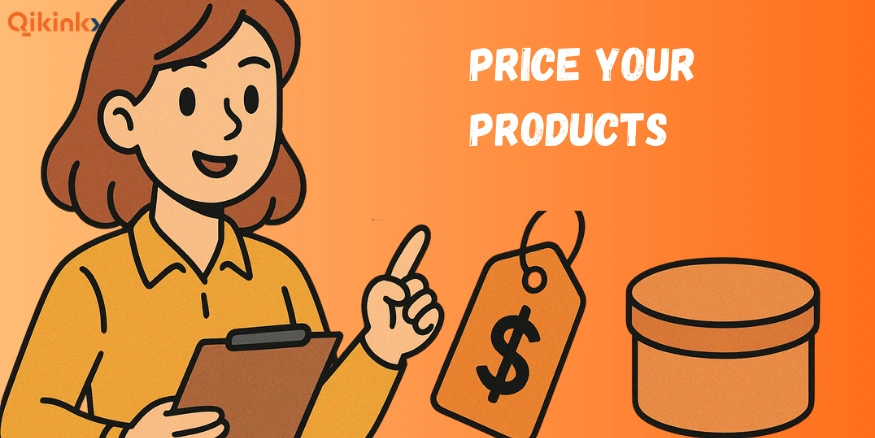
Setting the right prices for your products is crucial for profitability and competitiveness. Consider the following to price your products effectively:
The Three Key Stages of Profit
Gross Revenue
- Total sales collected from customers.
- Formula: Retail Price × Number of Items Sold.
Gross Profit
- Revenue left after subtracting the Cost of Goods Sold (COGS).
- COGS typically includes:
- Blank product base cost
- Printing & fulfillment fees
- Shipping costs
- Formula: Gross Revenue – COGS
Net Profit
- Actual take-home profit after subtracting all operating expenses (ads, platform fees, design costs, payment fees, etc.) from gross profit.
- This is the most important measure of business health.
Example: POD T-Shirt Business
- Retail Price (per T-Shirt): ₹699
- COGS:
- Blank shirt = ₹250
- Printing & fulfillment = ₹149
- Total = ₹399
- Gross Profit (per t-shirt): ₹699 – ₹399 = ₹300
If you sell 100 t-shirts/month:
- Gross Revenue: ₹69,900
- Gross Profit: ₹30,000
Now subtract monthly operating expenses:
- Marketing ads = ₹5,000
- E-commerce platform fees = ₹3,000
- Payment gateway fees (~2%) = ₹1,400
- Total Expenses = ₹9,400
Net Profit: ₹30,000 – ₹9,400 = ₹20,600
Your realistic monthly profit is ₹20,600, not the gross ₹30,000.
Key Takeaways to Maximize Profitability
- Track net profit, not just sales.
- Set smart prices that reflect costs, value, and brand positioning.
- Focus on unique, high-quality designs to command higher margins.
- Build a brand identity that attracts loyal buyers and reduces ad costs.
- Invest marketing budget into channels with the highest ROI.
Trying to figure out your profit on Print on Demand?

Step 9: Promoting Your Store With Marketing Strategies

Even the best store won’t succeed without traffic. To grow your Print-on-Demand business, you need a solid marketing plan that attracts and engages your target audience.
1. Segmentation & Personalization
Identify your target audience and tailor your approach. Younger customers may respond to meme-based t-shirts on Instagram, while older groups may engage more through Facebook or email. Personalization like showing products based on customer interests, helps you grab and retain attention.
2. Social Media Marketing
Focus on the social media platforms where your audience spends the most time instead of trying to be everywhere. Instagram and Pinterest work best for visual products like apparel, mugs, and posters. Use a mix of:
- Regular posting with high-quality mockups and lifestyle photos
- Behind-the-scenes content and sneak peeks of new designs
- Interactive posts (polls, quizzes, Q&As, and giveaways)
- User-generated content to build community and trust
Consistency is key to building brand loyalty.
3. Influencer Marketing
Collaborate with micro-influencers who have small but highly engaged audiences in your niche. Many are open to promoting products in exchange for free samples, while others may charge a fee. Influencers can help you tap into trusted communities and quickly spread brand awareness.
4. Content Marketing
Start a blog or create niche-focused content on social media. For example, if you sell fitness-themed apparel, post workout tips, motivational stories, or customer transformations. This builds your authority, improves SEO, and attracts organic traffic.
5. Email Marketing
Build and nurture a mailing list. Use emails to:
- Share new product launches
- Announce exclusive discounts or sales
- Remind customers about abandoned carts
- Deliver value through niche-related content
But remember, don’t spam inboxes. Stick to consistent, valuable updates that strengthen long-term relationships.
Step 10: Launch, Analyse, and Iterate

Launching your store is just the beginning. The key to long-term success is continuous improvement. Regularly checking your store’s performance helps you see what’s working and where to improve. Focus on these key metrics:
- Analyse Your Data: Use the analytics tools in Shopify or Google Analytics to see where your visitors are coming from and which products are selling best.
- Traffic – Track how many people visit your site and which channels bring the most.
- Conversion Rate – Check how many visitors actually buy. Low CR? Improve product pages or checkout.
- Average Order Value (AOV) – See how much customers spend per order. Boost it with bundles or free shipping offers.
- Customer Acquisition Cost (CAC) – Measure how much you spend to get a new customer. Lower it with organic marketing or referrals.
- Customer Lifetime Value (CLV) – Track how much revenue one customer brings over time. Increase it with loyalty programs or subscriptions.
- Return Rate – Monitor how many products get returned. High RTO Rate mean you may need to improve product quality or descriptions.
- Gather Customer Feedback: Encourage reviews and listen to what your customers are saying. Use their feedback to improve existing products and brainstorm new ideas.
- Double Down on What Works: If a particular design or marketing channel is performing well, invest more time and resources into it. Be prepared to adapt and evolve your strategy based on real-world results.
Keeping an eye on these numbers helps grow your POD business smarter and faster.
Is a Print-on-Demand Business Model Suitable for You?
Print on Demand can be a great way to enter eCommerce, but whether it’s the right model depends on your goals, skills, and expectations. Here’s a quick guide to see if it’s a good fit.
Print-on-Demand is great for you if:
- You’re creative: Artists and designers can sell their work on products with almost no risk.
- You have an audience: Influencers and content creators can easily sell merchandise to their existing fans.
- You want to test ideas: It’s a low-cost way to try out a new business or product idea without buying inventory.
- You know a specific niche: You can create products for a passionate community (like pet lovers or hobbyists) that are hard to find elsewhere.
- You need a flexible side job: You can run the business from anywhere online alongside your main job.
Print-on-Demand might be difficult for you if:
- You want high profits: Your profit margin on each sale is lower because the printing partner takes a large cut.
- You need full control: You have to rely on your supplier for product quality and shipping, which can impact your brand’s reputation.
- You dislike marketing: You can’t just upload designs and wait. Success requires actively marketing your store to find customers.
- Your customers expect fast shipping: Products are printed after an order is placed, so delivery takes longer than with major online retailers.
Print-on-Demand Revenue & Growth
Global Print-on-Demand Revenue & Growth
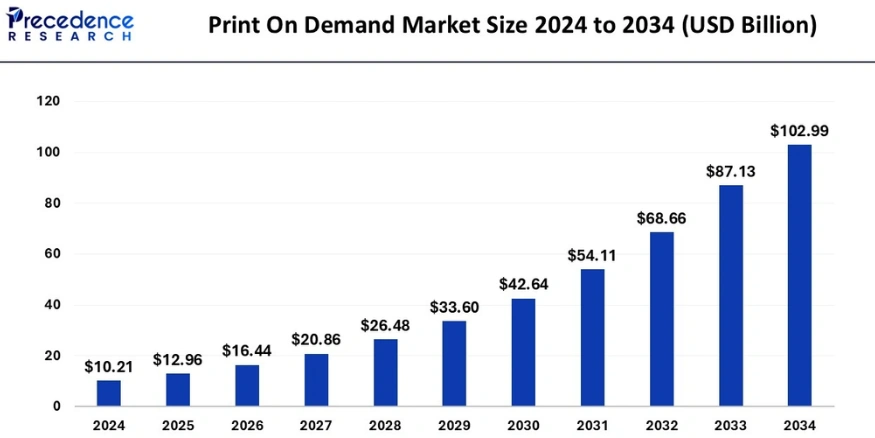
According to Precedence Research, the global Print-on-Demand market was valued at USD 10.21 billion in 2024 and is expected to skyrocket to USD 102.99 billion by 2034, growing at a strong CAGR of 26% (2025–2034).
Similarly, Grand View Research projects the market will reach USD 57.49 billion by 2033, expanding at a CAGR of 23.3%.
In short, the global Print on demand industry is set to grow more than 5–10× over the next decade, proving its position as one of the fastest-rising segments in eCommerce.
India Print-on-Demand Market: Rapid Acceleration
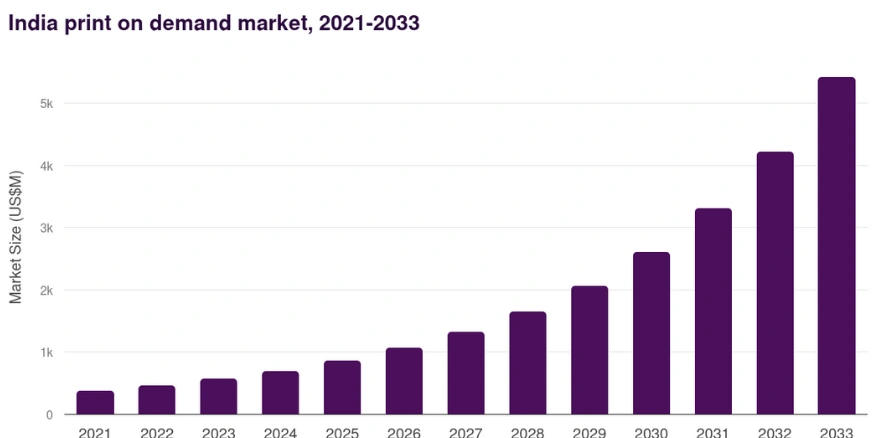
In India, the growth story is even more striking. Grand View Research valued the Indian POD market at USD 695.8 million in 2024, predicting it will expand to USD 5.419 billion by 2033 at a CAGR of 25.9%.
Similarly, Straits Research reported a comparable base of USD 652.2 million in 2024, with forecasts reaching USD 5.931 billion by 2033, reflecting an even higher CAGR of 27.8%.
India alone accounted for around 7.8% of global POD revenue in 2024, underlining its growing importance in the worldwide market.
Why This Matters
- Global context: The POD market is exploding worldwide, set to exceed USD 100 billion by 2034. For entrepreneurs, this highlights massive potential in building sustainable online brands.
- India-specific insights: Although still developing, India’s POD market is expected to grow nearly 8–9× over the next decade, signaling untapped opportunity.
- Big picture: With CAGRs of 25–28%, POD offers one of the most exciting growth opportunities in eCommerce, especially in India, where digital adoption and demand for personalized products are rapidly rising.
Know the actual cost of running a business using print on demand!

Pros of Print on Demand
- Low Cost to Start You don’t need to buy any products upfront. This means you can launch your business with very little financial risk.
- No Inventory Management You never have to worry about storing, packing, or shipping orders. Your print-on-demand partner handles all the logistics.
- Wide Range of Products You can sell dozens of different items like apparel and mugs. This allows you to offer more choices without any extra cost.
- Creative Freedom and Focus You can concentrate on what you do best: creating great designs and marketing your brand, while leaving production to others.
- Easy to Experiment You can test new product ideas and designs without any risk. If something doesn’t sell, you haven’t lost any money.
- Location Independent You can run your entire business from anywhere in the world. All you need is a laptop and an internet connection.
Cons of Print on Demand
- Lower Profit Margins The cost per item is higher than buying in bulk. This means you will make less profit on every sale.
- Dependence on Your Supplier Your brand’s reputation for product quality and shipping speed is entirely in your partner’s hands, not yours.
- Longer Shipping Times Since every item is printed to order, customers have to wait longer. This doesn’t meet the fast shipping expectations some may have.
- Limited Customization You have little control over the customer’s unboxing experience. You can’t add custom packaging, notes, or branded tags.
- You Manage Customer Service You are responsible for handling all customer complaints and issues, even when the mistake is made by your supplier.
- Competitive Market It’s easy for anyone to start a print-on-demand store. This means you’ll need great designs and marketing to stand out from the crowd.
Start Your Print-on-Demand Business with Qikink
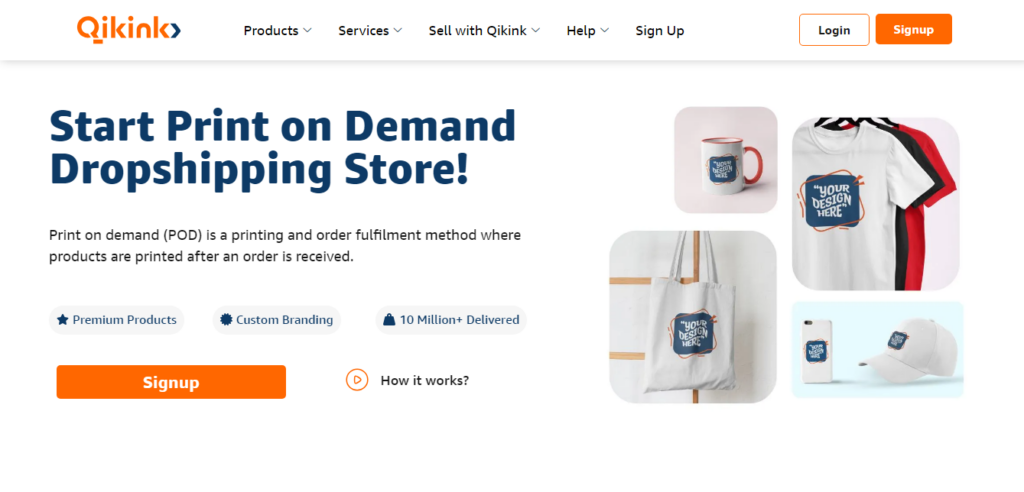
If you’re planning to launch a Print-on-Demand business in India, Qikink offers an all-in-one solution that simplifies design, printing, fulfillment, and branding.
Starting an online business in India can seem daunting, with challenges like high investment, inventory management, and shipping logistics. Qikink eliminates these barriers with its powerful Print-on-Demand Dropshipping model, allowing anyone to launch a professional e-commerce brand with zero upfront cost.
Why Choose Qikink?
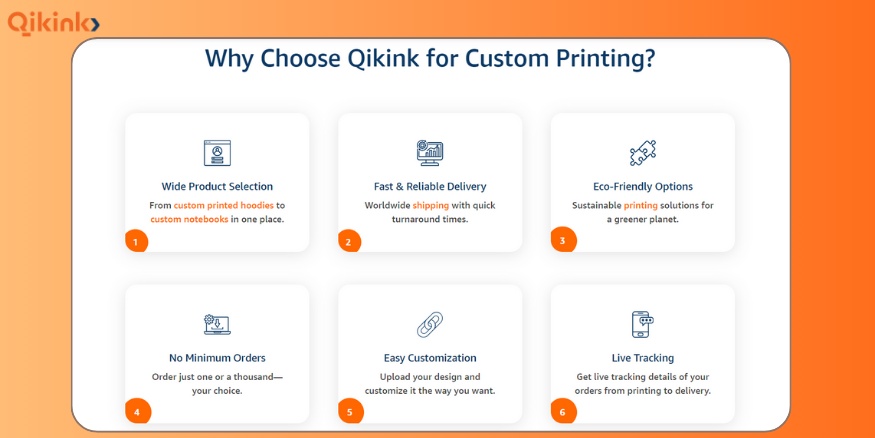
- Zero setup cost: Sign up for free with no documents, minimum orders, or business registration required
- Wide product range: Customizable products include apparel (t-shirts, hoodies, AOP apparel), accessories (mugs, phone cases, tote bags), plus home & living items like posters, notepads, coasters, and more
- Fast fulfillment: Standard orders ship within 2 working days, and all-over-print (AOP) items within 3–4 days, total delivery typically takes 3–5 working days.
- Eco-friendly packaging: Uses sustainable packaging like corrugated cardboard boxes for a premium unboxing experience with custom branding options like inside neck labels, thank you/coupon cards, hang tags, free logo stickers on courier packages, and thank you sticker cards with lifetime free neck label re-fills
- Multiple print technologies: Offers DTG, DTF, Vinyl, Sublimation, Embroidery, and AOP printing to suit various design needs
- Trusted partner: Many Indian brands praise Qikink for consistent quality, responsive customer service, and reliability.
- Zero RTO (Return-to-Origin) Charges: Qikink removes the worry of return shipping fees on undelivered or refused orders—those are on them, not you. This significantly helps maintain your profit margins and reduces customer dissatisfaction.
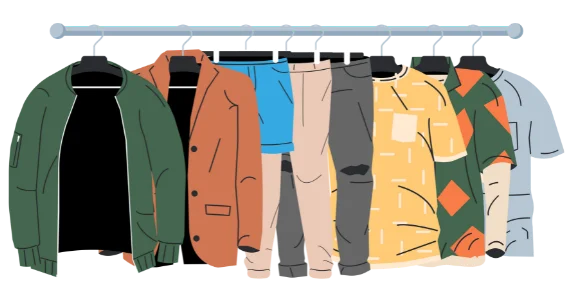
Step-by-Step: Launching Your Store with Qikink
1. Create Your Qikink Account
2. Set Up Your Online Store
Qikink integrates with Shopify and WooCommerce, enabling automated product and order syncing
3. Design Your Products
4. Add Designs & Push Products
Upload your designs and use Qikink’s “Push Product” feature to sync items directly into your store. Alternatively, use their mockup generator if you’re using a custom store setup
5. Set Pricing & Payment Gateway
Define product pricing thoughtfully, consider including tax and shipping in the price or adding them at checkout. Integrate local payment gateways such as Razorpay, etc
6. Order Samples
Test quality by ordering samples yourself before going live to ensure the material, print, and delivery meet your expectations
7. Launch & Market Your Store
Once live, drive traffic through digital marketing: social media, content creation, influencer collaborations, or paid ads to attract your first customers
8. Earn While They Handle Fulfillment
After customers place orders, Qikink handles printing, packaging, and shipping, allowing you to focus on growing your brand
Qikink makes starting a POD business in India highly accessible and straightforward. With no setup barriers, fast delivery, eco-friendly packaging, and seamless integration, it’s a compelling choice for beginners and experienced sellers alike.
Conclusion
Starting a Print on Demand business in India is one of the most accessible ways to enter eCommerce with minimal risk and investment. With rising demand for personalized products, affordable online store setups, and reliable partners, entrepreneurs can build profitable brands without handling inventory or logistics.
The key to success lies in choosing the right niche, creating unique designs, pricing smartly, and building a strong brand presence. While challenges like lower margins and shipping times exist, the opportunity to scale and reach a wide audience is massive. If you’re creative, willing to learn marketing, and ready to start small, Print on demand can be a powerful stepping stone toward building your own online business in India.
Read More
- Most Demanding Products to Sell Online In India
- How to Start an eCommerce Business Without Money
- 24 Best Print on Demand Sites in India
- Print on Demand Business Revenue & Market Size
- Start a Profitable T-Shirt Selling Business from DAY 1
- Top 30 Online Selling Platforms in India
- How to Sell on Etsy India – Guide
Frequently Asked Questions
How much does it cost to start a POD business in India?
It doesn’t require a big investment to start a POD business in India. Your main costs include setting up your online store, marketing, and creating designs. Since most POD platforms handle printing and inventory, there are no upfront stock expenses.
Which is the best platform for Print-on-Demand in India?
The best platform for Print-on-Demand in India is Qikink, as it offers a wide product range, reliable printing quality, and fast shipping tailored for Indian sellers. It’s designed to help entrepreneurs scale their POD business easily.
Can Print-on-Demand be profitable in India?
Yes, POD can be profitable in India if you focus on the right niche, create unique designs, and market effectively. With growing demand for personalized products, it offers strong earning potential.
What challenges should I expect in POD?
Some challenges include longer shipping times, thinner margins than bulk manufacturing, and high competition. However, partnering with a reliable POD provider like Qikink can minimize these issues.

